2016 KAWASAKI KX250F MXA RACE TEST: EVERYTHING YOU NEED TO KNOW
Q: FIRST AND FOREMOST, IS THE 2016 KAWASAKI KX250F BETTER THAN THE 2015 KX250F?
A: No. Why not? Because the 2016 Kawasaki KX250F is the 2015 KX250F (with a green rear fender). One of the conundrums of the Japanese manufacturer’s four-year development cycles is that the R&D programs run out of steam in year four. With a new bike on the horizon, it is hard to justify spending money on making substantive changes to a design that won’t be around in 12 months. That money is better spent on the next model.
There is no guarantee that Kawasaki will offer a total remake of the KX250F next year, but there is evidence to suggest it. In 2016, Kawasaki introduced an all-new KX450F. It was redesigned from the ground up. It was lighter, thinner andvastly improved. Based on history, it is logical to assume that the same chassis, engine and cosmetic changes will be made to the Kawasaki KX250F in 2017.
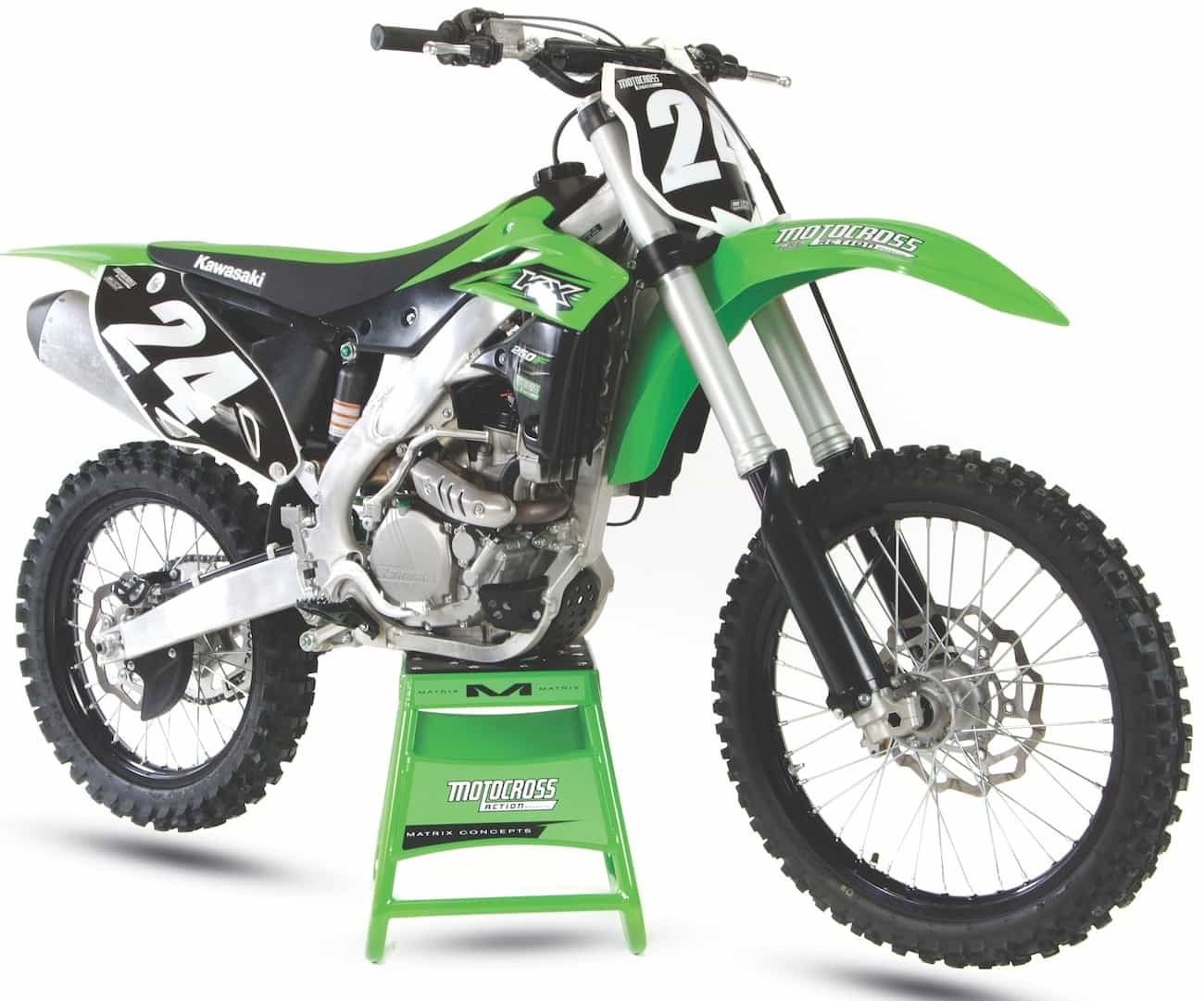 2016 Kawasaki KX250F: If you look closely, and are well educated in Kawasaki color schemes, you might notice the differences between a 2016 KX250F and the 2015 model.
2016 Kawasaki KX250F: If you look closely, and are well educated in Kawasaki color schemes, you might notice the differences between a 2016 KX250F and the 2015 model.
Q: WHAT CHANGES DID KAWASAKI MAKE TO THE 2016 KX250F?
A: It’s important to note that while the KX250F may be stagnating in 2016, Kawasaki did make modifications in 2015 to the piston, exhaust system, magneto rotor, ECU’s droplet size, SFF fork valving, axle wall thicknesses, graphics, rear axle nut, 270mm Braking front rotor, four-position handlebar mount slots, adjustable footpeg brackets and subframe, which leads us to the 2016 KX250F updates. Hold on to your hat.
(1) Rear fender. Last year the KX250F had a white rear fender. For 2016 it has been changed to green.
(2) Bearing retainer screws. The eight Phillips-head screws that hold the various bearing retainer plates on the 2016 engine have been upgraded in strength from 1000 N/m to 1200 N/m.
(3) Engine plugs. The engine plugs have been changed from green to a candy-apple color.
(4) Tank graphics. If we hadn’t told you, you would never know that the tank graphics are ever-so-slightly different from 2015.
Q: WHAT ARE THE BEST ATTRIBUTES OF THE 2016 KAWASAKI KX250F?
A: All motocrossers are drawn to newness like moths to a flame. So, when a brand’s latest offering isn’t new, we lose interest in it. MXA test riders are no different—we are always looking for the next flashy toy. But, that gives short shrift to the 2016 Kawasaki KX250F. We forget that the KX250F has been the defining 250cc four-stroke of the last decade. It won the “MXA 250 Shootout” crown in 2006, 2007, 2008, 2010, 2011, 2012, 2013 and 2014. And, one short year ago, in the 2015 MXA 250 shootout, it finished second to the Yamaha YZ250F but well ahead of the Suzuki, Honda, KTM and Husqvarna offerings. We aren’t talking about chopped liver here. This is a competitive motocross bike that still exudes considerable bravado, even if it has been the subject of benign neglect for 2016 by the powers that be at Kawasaki.
We accept that benign neglect is the way of the world in “year four” of any production cycle. Look no further than the 2016 Honda CRF450 and Suzuki RM-Z450 to see that the Kawasaki KX250F isn’t the only bike being left alone. However, it has been proven over and over again that bells and whistles, electronic gizmos, air forks and whiz-bang graphics don’t guarantee a better machine. The MXA wrecking crew knows first hand that a solid-performing machine with modest revisions often outperforms bikes that are new from the ground up. There is a lot to like about the 2016 Kawasaki KX250F. Here’s a quick list.
(1) Powerband. The KX250F’s potent powerband has served it well over the last decade. It may not be changed for 2016, but it is still a 40-horsepower 250cc motocross bike, and that is something that neither Honda nor Suzuki can claim. Plus, the KX250F powerband is well-positioned and targeted at the sweet spot.
(2) Dual-fuel injectors. The main reason the engine is so broad is due to the secondary upstream injector, which delivers fuel at a progressive rate as the engine rises from 7000 to 13,000 rpm. The upstream injector delivers fuel at a progressive rate at high rpm, while the downstream injector handles fuel delivery at lower rpm. This is a creative idea that may smack of the Rube Goldberg School of Design, but it actually works.
(3) Brakes. The Japanese brands may have dragged their feet into the wonderful world of KTM-style braking power, but the KX250F was one of the first to jump in with a 270mm front rotor.
(4) Adjustable footpegs. Kawasaki remains the only manufacturer that has footpeg brackets that can be moved up and down on the frame to better fit a variety of body types and leg lengths. When you add in the four-way adjustable bar mounts, the ability to get comfortable is one of the KX250F’s best attributes.
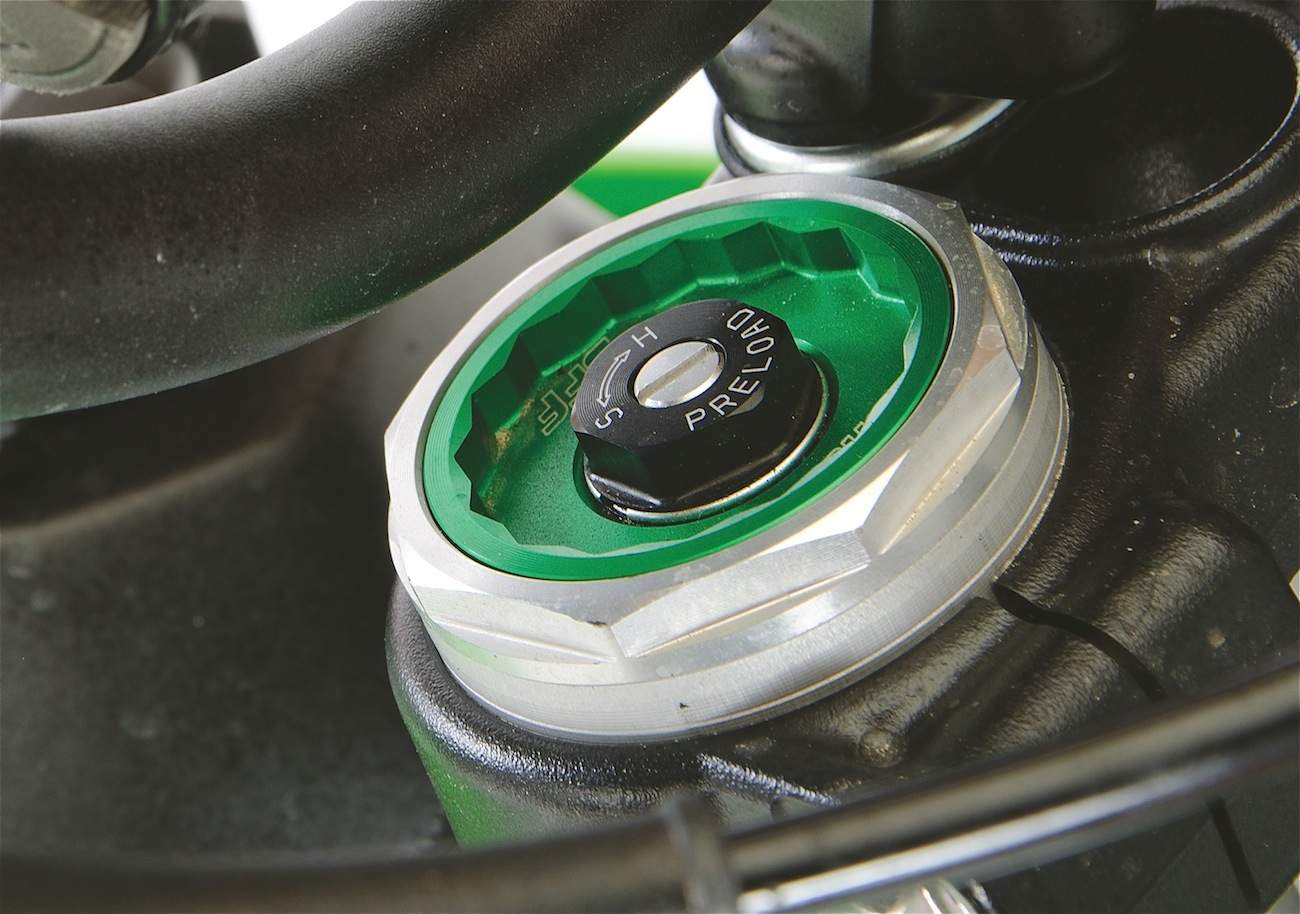 Frequency: The right fork leg houses the lone coil spring. The dial on the cap allows you to adjust spring preload.
Frequency: The right fork leg houses the lone coil spring. The dial on the cap allows you to adjust spring preload.
(5) Coil-spring forks. Let’s not get too misty about the coil spring (and we mean spring, not springs) in the 48mm Showa SFF forks. They have been standard fare on the KX250F since 2011 and have gone from less than stellar to workmanlike over their six-year run. Although we are in an age when consumers look at air forks with a gleam in their eyes, the promise of a simpler life—sans pumps, gauges and Apple Store apps—is appealing. The best thing about six-year-old SFF forks is that they have six years of aftermarket fine-tuning behind them. Don’t forget that the world-leading Yamaha SSS forks have springs in them and are 10 years old.
(6) Electronic aids. The KX250F was one of the first 250cc four-strokes to embrace adjustable maps and launch control. The three plug-in map couplers are easy to use, and every MXA test rider prefers the aggressive white coupler. As for launch control on a 250cc four-stroke, we have our doubts about its effectiveness for a talented rider, and not even the Vet test rider opted to run it, but it might be of use for Beginners and concrete starting pads.
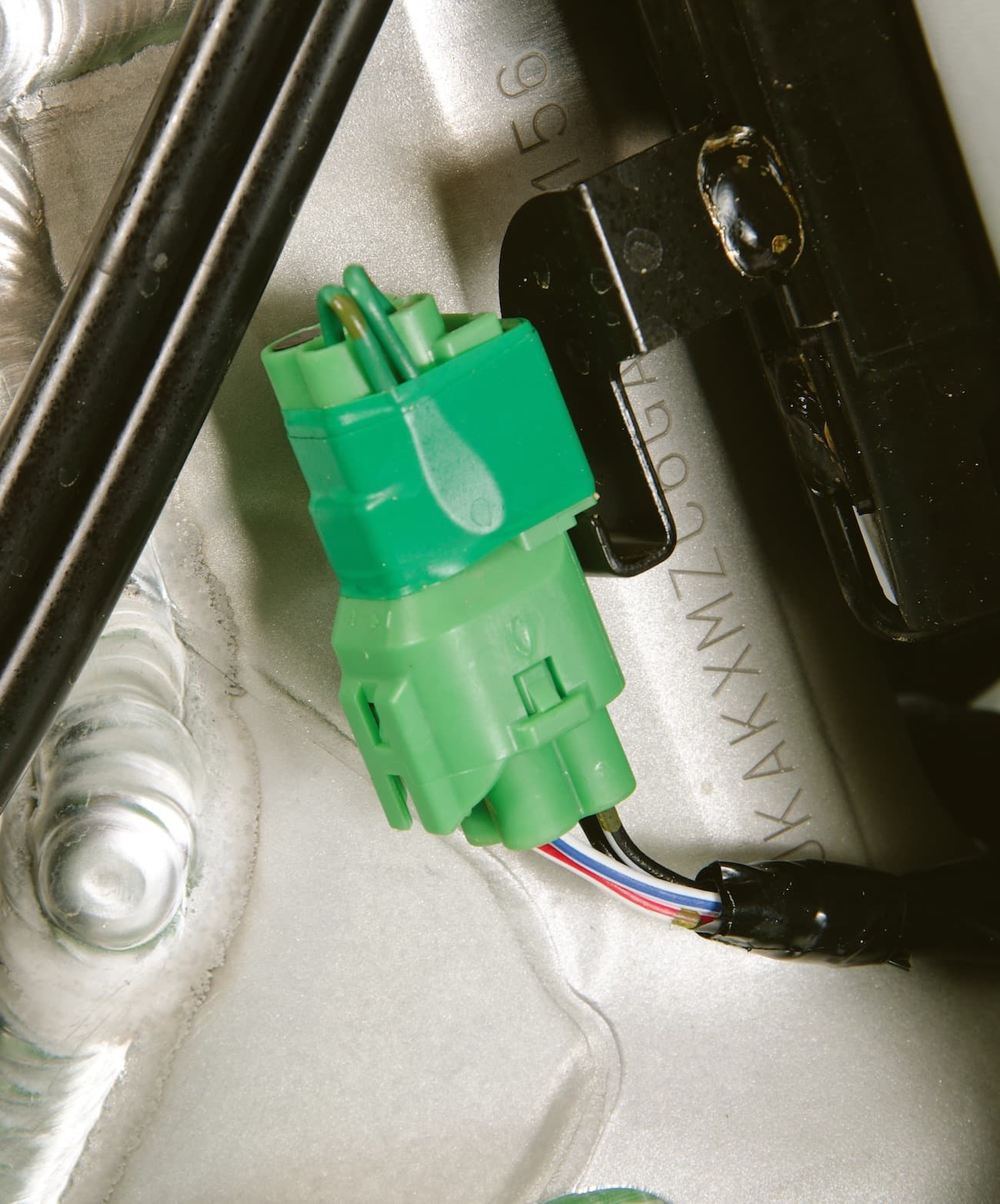 Couplers: This is the stock green coupler. Every MXA test rider prefers to race with the white coupler instead.
Couplers: This is the stock green coupler. Every MXA test rider prefers to race with the white coupler instead.
Q: WHAT ARE THE WORST ATTRIBUTES OF THE 2016 KX250F?
A: MXA test riders spend every waking minute working on, riding and analyzing new bikes. As much as we focus on finding the good in the machines we ride, it’s hard not to see the chinks in a bike’s armor. Here are the KX250F’s chinks.
(1) Business model. By virtue of the four-year development cycle, the 2016 KX250F is an orphan bike. Kawasaki’s benign neglect not only signals that there will be an all-new KX250F in 2017, but that it has no plans to develop this rolling chassis any further. The message to the consumer is caveat emptor. If you buy this bike, you are buying the last of the line. You don’t need Sherlock Holmes to tell you that the resale value will fall as soon as the 2017 model is introduced.
(2) Handling. It is a lot cheaper to make a slow bike fast than a bad-handling bike into a carver. The KX250F line’s eight shootout-winning years were achieved in spite of its stodgy, upright, old-school handling. The meanest thing that an MXA test rider ever said about the handling of a KX250F was that “it handles like a tug boat.” Harsh, but it doesn’t handle like a speed boat.
(3) Clutch. The four Japanese brands would have gone merrily on their way with the pitiful clutches they had foisted on the public had KTM not come along with its absolutely brilliant hydraulic system. Once racers learned how good a clutch could be, not just in metering forward drive but by self-adjusting the lever play, doubling the clutch plates’ life and making the ham-fisted feel superior, they gave marginal clutches, like the one on the KX250F, the stink eye. Stiffer clutch springs are a must-have.
(4) Shifting. The KX250F transmission refuses to upshift without resistance, particularly under duress. We learned to use the clutch to our advantage, although doing so aggravates the clutch issues.
(5) Chain guide. Kawasaki’s engineers need to call (541) 772-4161 for much-needed advice. That is the phone number to T.M. Designworks. If they don’t call, you should, because the stock chain guide has the lifespan of a gypsy moth.
(6) Grips. They’re too hard and too painful for most hands. Plus, Kawasaki still vulcanizes the clutch-side grip to the handlebar so that it takes dynamite to replace it. We are forced to buy an aluminum throttle tube just to run the grips we want.
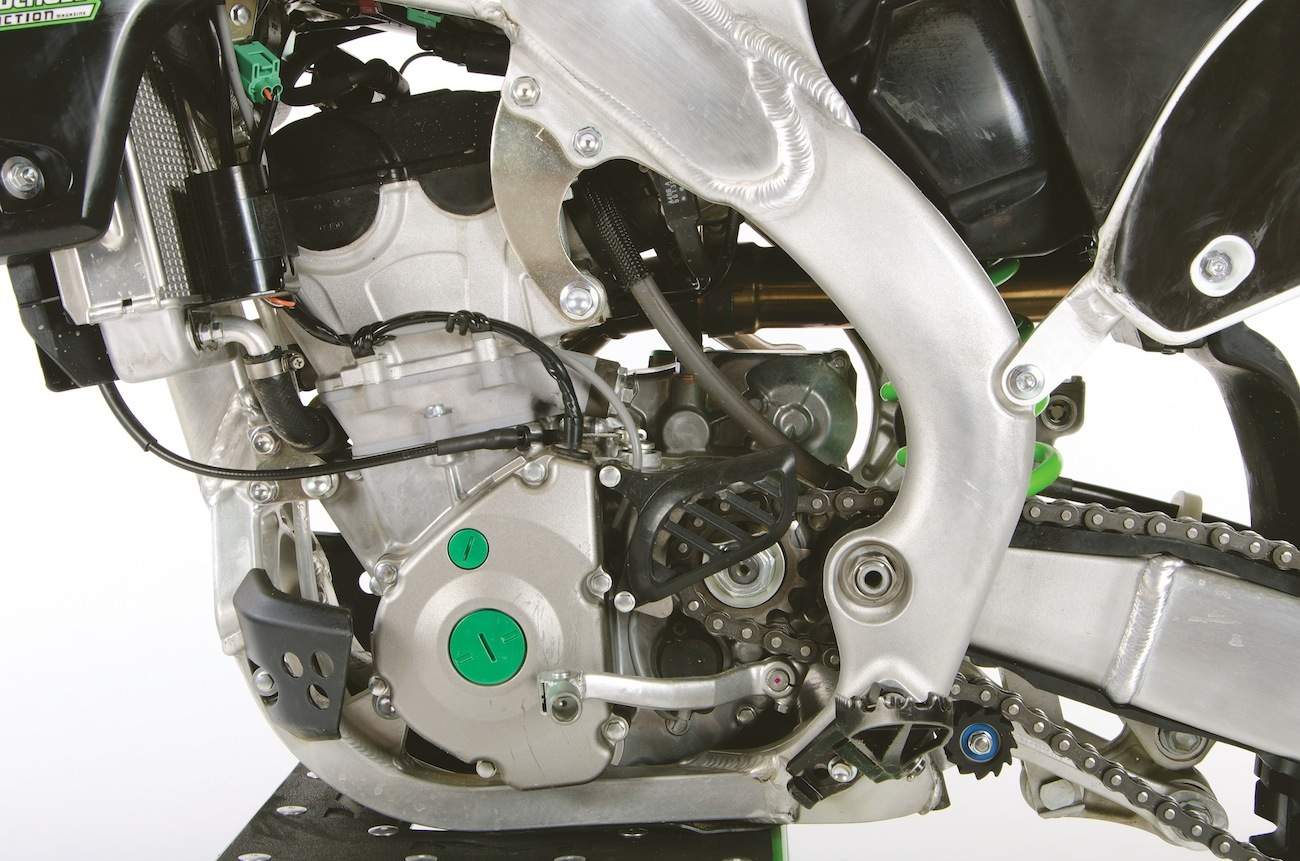 Romance: The MXA test riders love the KX250F’s instant-on style of power. It is a 40-horse catapult.
Romance: The MXA test riders love the KX250F’s instant-on style of power. It is a 40-horse catapult.
Q: HOW DOES IT RUN ON THE DYNO?
A: The magic dyno number in the 250 class used to be 40 horsepower. But the magic went out of the number when the 2016 Husqvarna pumped out 44.34 horsepower and was joined by its twin brother the KTM 250SXF in the rare air of the mid-40s. That means that while Kawasaki was the first to break the big four-oh barrier four years ago, they are now part of a four-bike club akin to the one Chuck Yeager started. At 39.87 horsepower, the KX250F is one full horsepower above the 38.89 horsepower of the 2016 Honda CRF250 and 38.35 horsepower of the 2016 RM-Z250, but well below the Austrian duo.
Q: WHAT IS THE SUGGESTED RETAIL PRICE OF THE 2016 KX250F
A: Kawasaki has not raised the price of the KX250F since 2013. It retails for $7599. How does that compare to the competition? The CRF250 is also $7599. The YZ250F is $9 cheaper at $7590. The RM-Z250 is $100 more expensive at $7699. The KTM 250SXF is $800 more at $8399. The Husqvarna FC250 cost $900 more at $8499.
Q: WHAT DOES THE 2016 KX250F WEIGH?
A: Tipping MXA’s scales at 226 pounds, the KX250F is 5 pounds heavier than the KTM 250SXF and Yamaha YZ250F, 3 pounds heavier than the Husqvarna FC250, 2 pounds heavier than the Honda CRF250 and the same weight as the Suzuki RM-Z250.
Q: WHAT DID WE HATE?
A: The hate list:
(1) Shifting. Kawasaki has gone ’round and ’round trying to improve the shifting traits on the KX250F. Unfortunately, the KX250 doesn’t readily shift under a load. Use the clutch or breathe the engine to get it to upshift at speed.
(2) Triple clamps. We installed 22mm offset triple clamps. The different trail made cornering more precise in all situations.
(3) Shock linkage. We ran a longer pull rod to stiffen the initial part of the stroke while lowering the seat height. We aren’t the only ones doing this as virtually every KX250F on the National circuit has a longer Pro Circuit link on it.
(4) Clutch. At the very least, add stiffer clutch springs.
(5) Chain guide. We run a T.M. Designworks chain guide kit on every Kawasaki we test. If you don’t replace the stock chain guide, your chain will saw right through it.
(6) Grips. The grips are small and hard (just like your ex-girlfriend’s cheating heart).
(7) Handling. The 2016 KX250F is not the best-handling bike in the class—not even close. That should go without saying, because the same thing has been true with every KX250F since the original Suzuki/Kawasaki Alliance machines of 2004.
(8) Tires. We were surprised to find old-school Dunlop MX51 tires on both ends of the 2016 KX250F. Not pleasantly surprised.
(9) Decibels. When you turn the throttle wide open, you know it. You can hear it loud and clear—so can the scientists at Cal Tech, because it produces a 7 on the Richter scale.
(10) Brakes. Word of warning. We had to bleed the front brake after the first hour of riding. It got spongy quickly. New fluid perked it up.
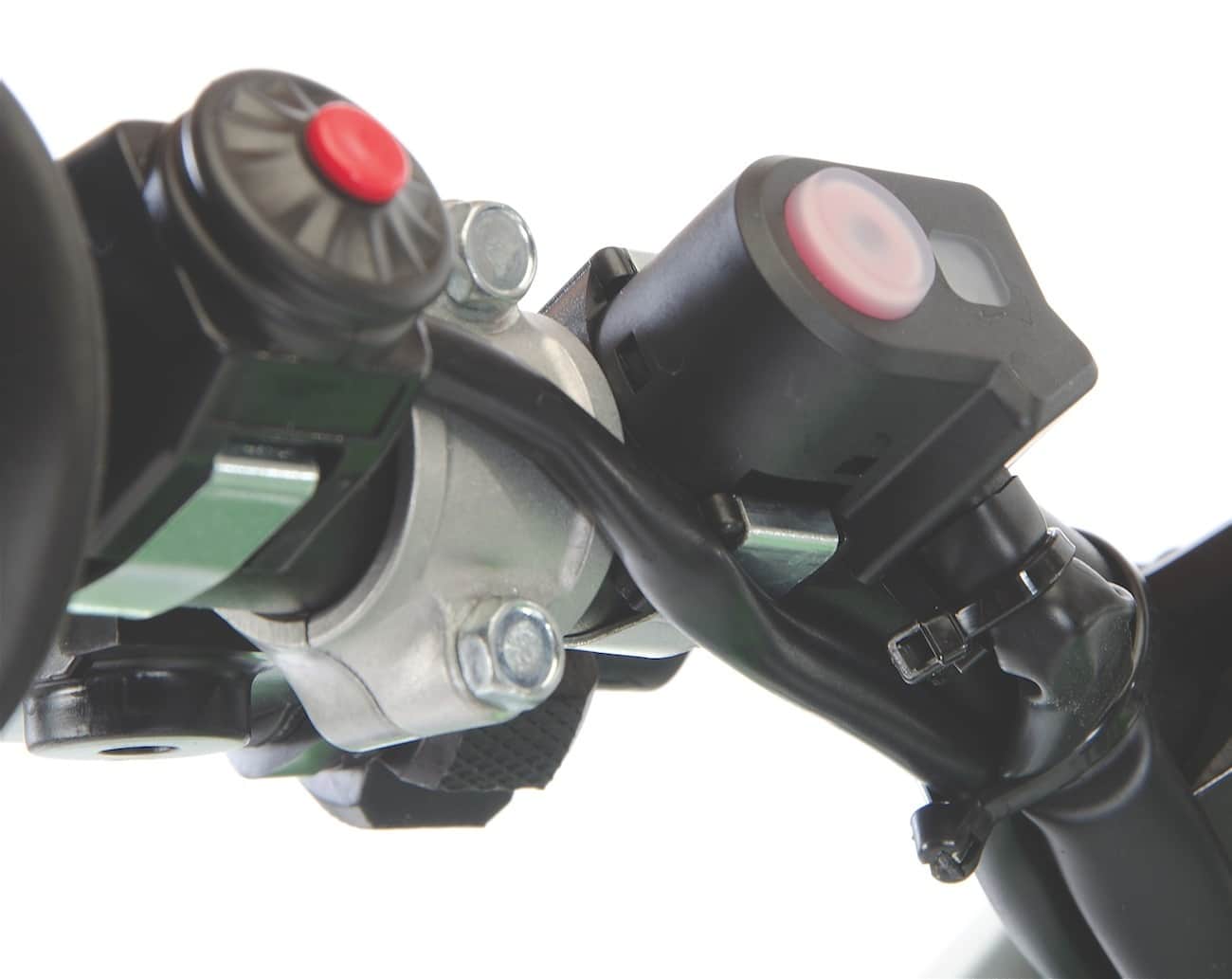 Add-on: You might be tempted to use launch control on the 2016 Kawasaki KX250F, but we never were.Q: WHAT DID WE LIKE?
Add-on: You might be tempted to use launch control on the 2016 Kawasaki KX250F, but we never were.Q: WHAT DID WE LIKE?
A: The like list:
(1) Engine. This engine rocks. Every MXA test rider has an unhealthy infatuation with the way the KX250F runs. The power is right where you need it—with a solid blast that doesn’t hesitate. A two-minute ride on a KX250F will leave you in love with the KX250F powerband. Yes, the engine design may be getting long in the tooth, but it still has plenty of bite left.
(2) Upstream injector. The main reason the engine is so broad is due to the dual injectors, which can cover the engine’s fuel needs from off-idle all the way to 13,000 rpm.
(3) Couplers. Riding a loamy track? Plug in the white coupler. Are you racing across hardpack? Simply install the black coupler. It’s that easy.
(4) Ergos. The four-position bar mounts and adjustable footpeg height make the ergonomics easy to dial in. This is the only 250 that caters to tall riders.
(5) Rear axle nut. We always hated the cotter pin on the KX250F’s rear axle. Thankfully, in 2015, they upgraded to a self-locking rear axle nut. It’s the little things in life that mean the most.
Q: WHAT DO WE REALLY THINK?
A: The Suzuzki RM-Z250 is defined by its ability to turn, the Honda CRF250 by its agile feel, the Yamaha YZ250F by its brilliant coil-spring forks, the Husqvarna FC250 by its new-school looks and the KTM 250SXF by its willingness to rev to 14,000 rpm. As for the Kawasaki KX250F? It’s all about the powerband, baby. In truth, the rest of the bike is average at best, but, in the past, we’ve been willing to overlook the KX250F’s obvious shortcomings for the thrill of the throttle. You know what? We still are.
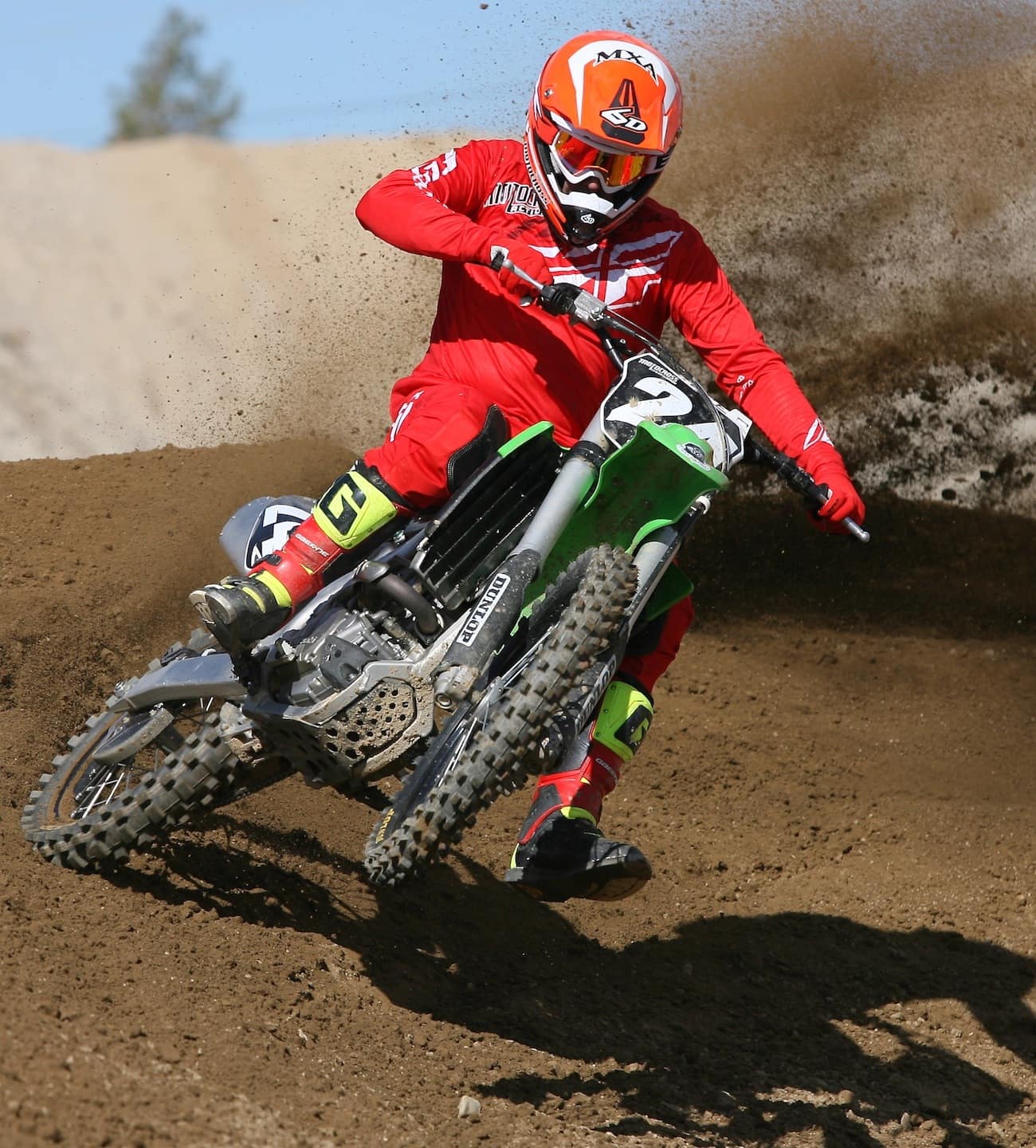 Acronym: SFF stands for Single Function Fork, but on the KX250F it should be SSF for Single Spring Fork.
Acronym: SFF stands for Single Function Fork, but on the KX250F it should be SSF for Single Spring Fork.
MXA’S KAWASAKI KX250F SETUP SPECS
This is how we set up our 2016 Kawasaki KX250F for racing. We offer it as a guide to help you get your own bike dialed in.
SHOWA SFF FORK SETTINGS
Air forks generate a lot of buzz, but they also generate a lot of swear words. There is something reassuring about coil spring forks. The 48mm Showa SFF single-spring forks have come standard on the KX250F since 2011. The baseline settings have improved every year, as Kawasaki has focused on targeting a wider range of riders. What’s unique about the SFF forks is that the preload can be adjusted to either raise or lower the ride height. Ride height is very important, as it determines the handling traits. For hard-core racing, we recommend this fork setup for the 2016 Kawasaki KX250F (stock specs are in parentheses):
Spring rate: 0.96 N/m
Compression: 15 clicks out (7 clicks out)
Rebound: 10 clicks out
Preload adjuster: All the way out (8 clicks in)
Fork-leg height: 5mm up
Notes: Fast riders on jump tracks will find the forks to be in the ballpark. Slower riders on rougher tracks will think they are too harsh. For Vets and Novices, we went all the way out on the compression clickers (and in some cases lowered the oil by 10cc in the left fork leg).
SHOWA UNI-TRAK SHOCK SETTINGS
Too much emphasis on the front end causes oversteer at turn-in, while less emphasis on the front allows the bike to stand up in mid-corner. MXA installs a longer shock linkage to stiffen the initial part of the shock’s stroke and drop the rear of the chassis to allow for more fork height options. For hard-core racing, we recommend this shock setup for the 2016 Kawasaki KX250F (stock specs are in parentheses):
Spring rate: 5.3 N/m
Race sag: 100mm
Hi-compression: 2 turns out
Lo-compression: 11 clicks out
Rebound: 14 clicks out
Notes: These settings are geared toward a faster rider. We think that the KX250F works best with the low-speed compression turned in while using the high speed to adjust the ride height at speed. Kawasaki also offers 47, 49, 51 and 55 N/m springs.
MXA FIRST RIDE: 2016 KAWASAKI KX250F



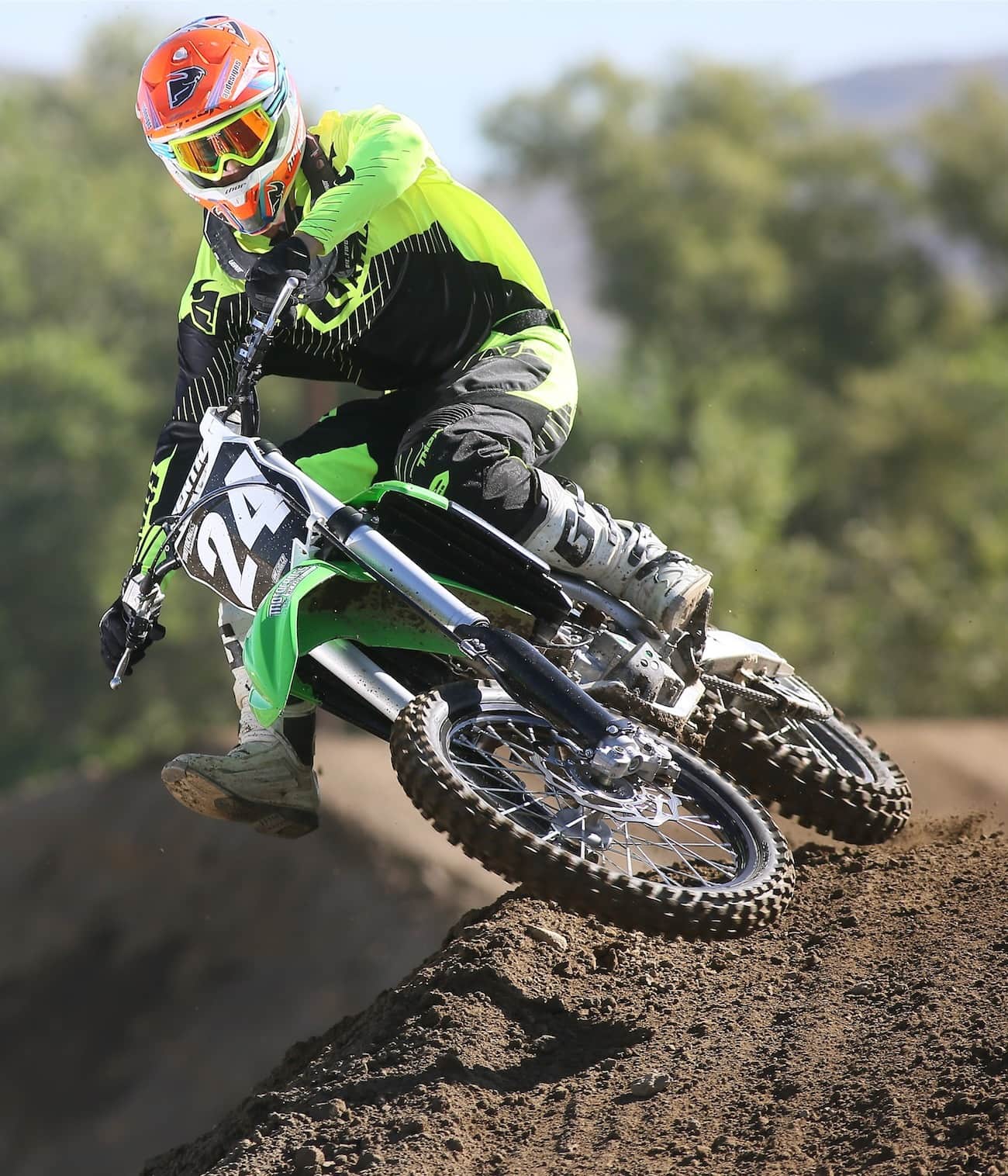
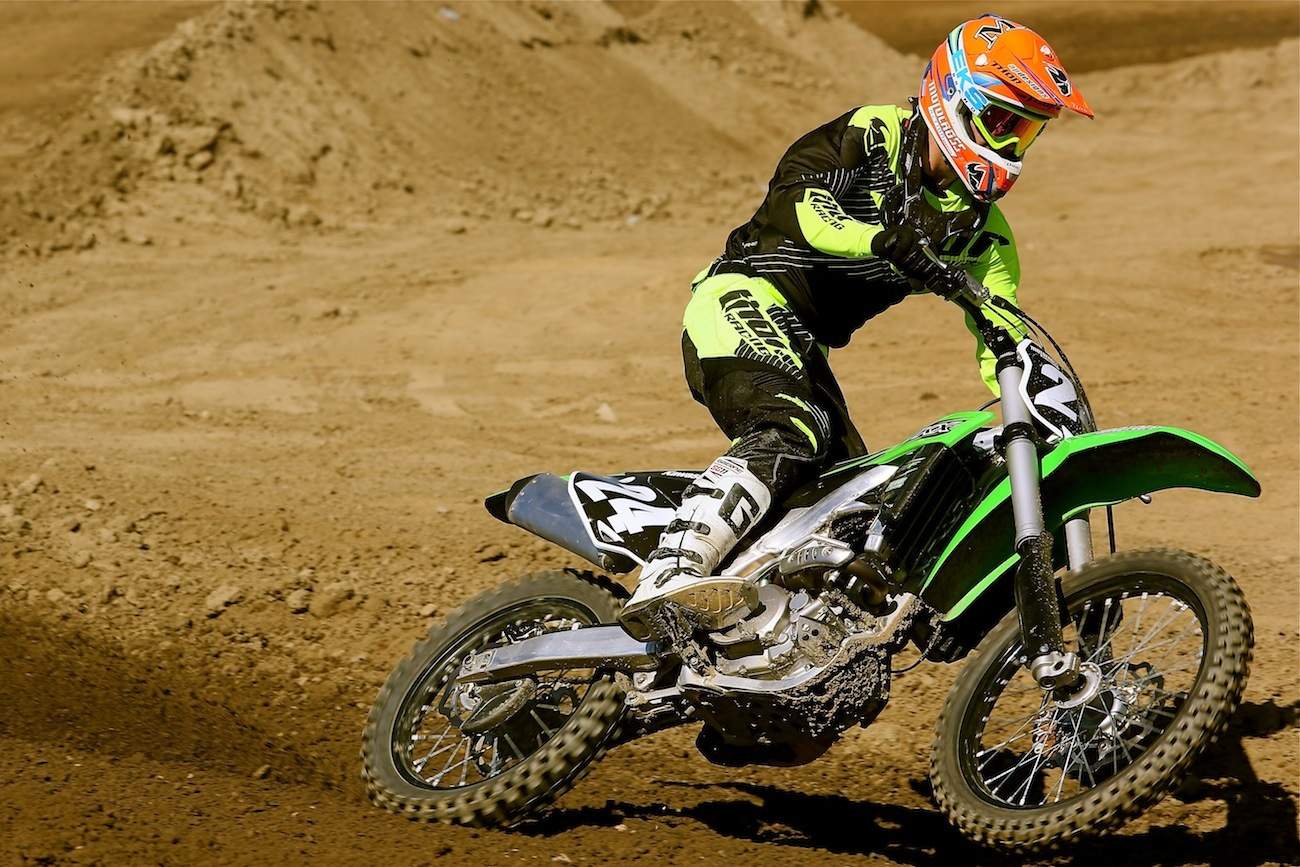

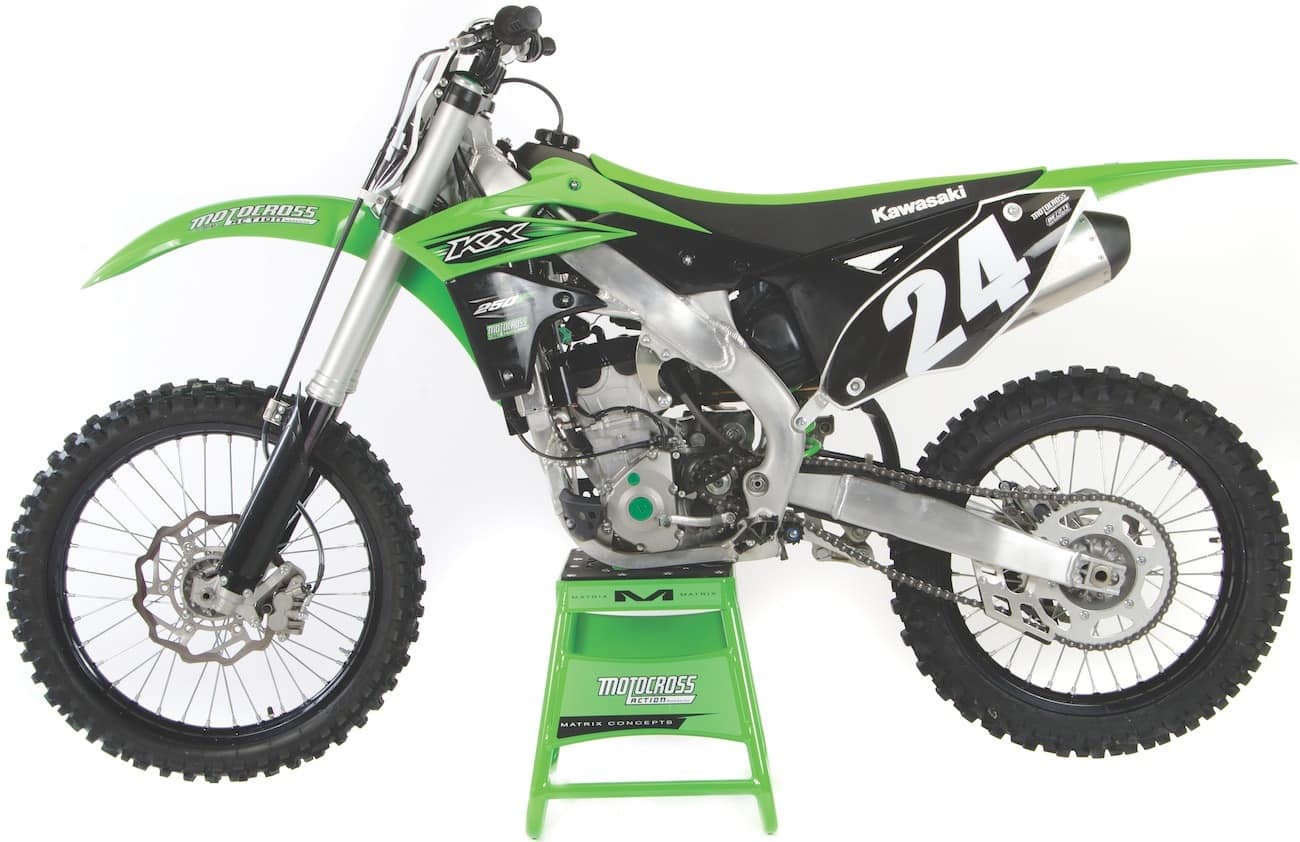
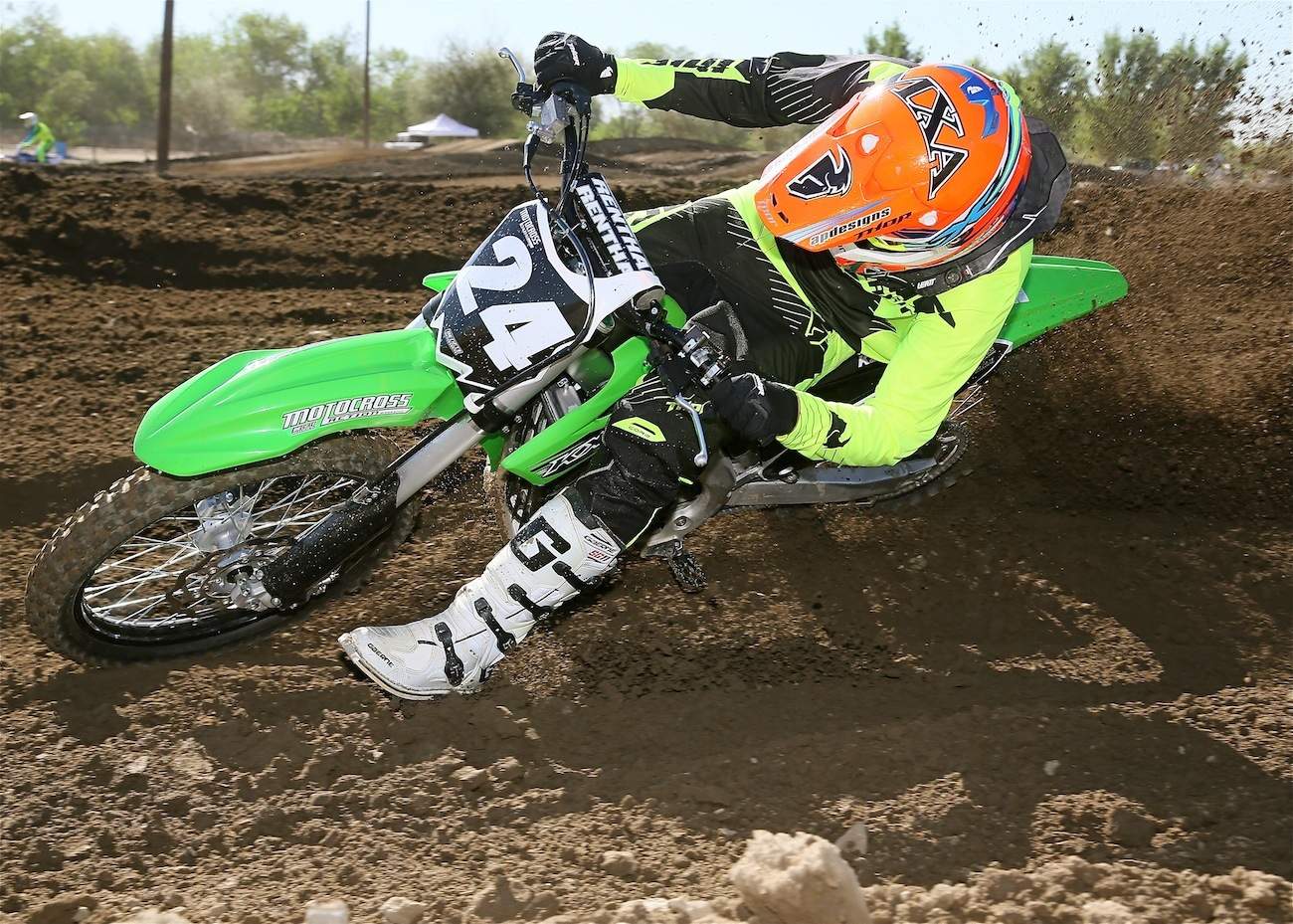



Comments are closed.